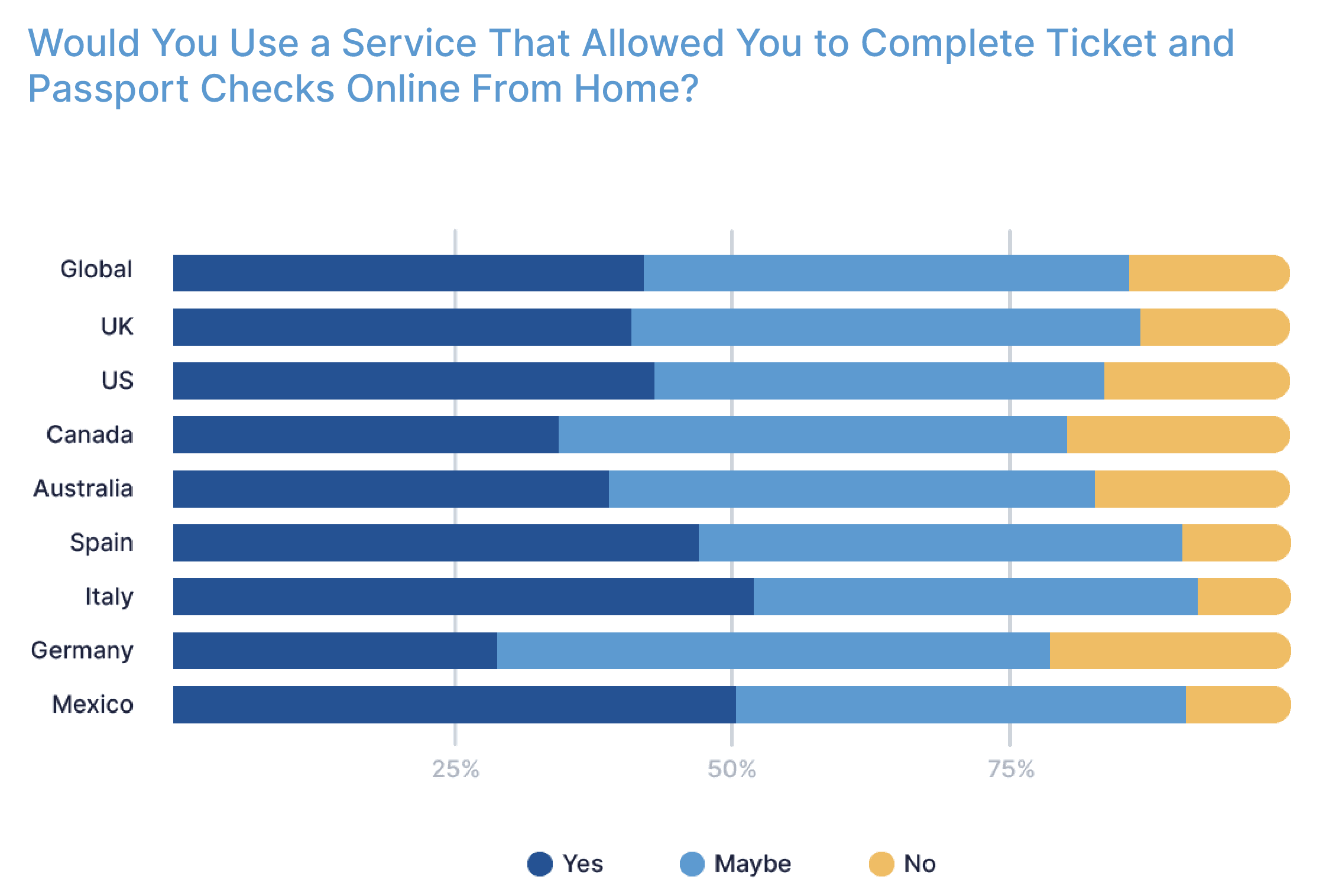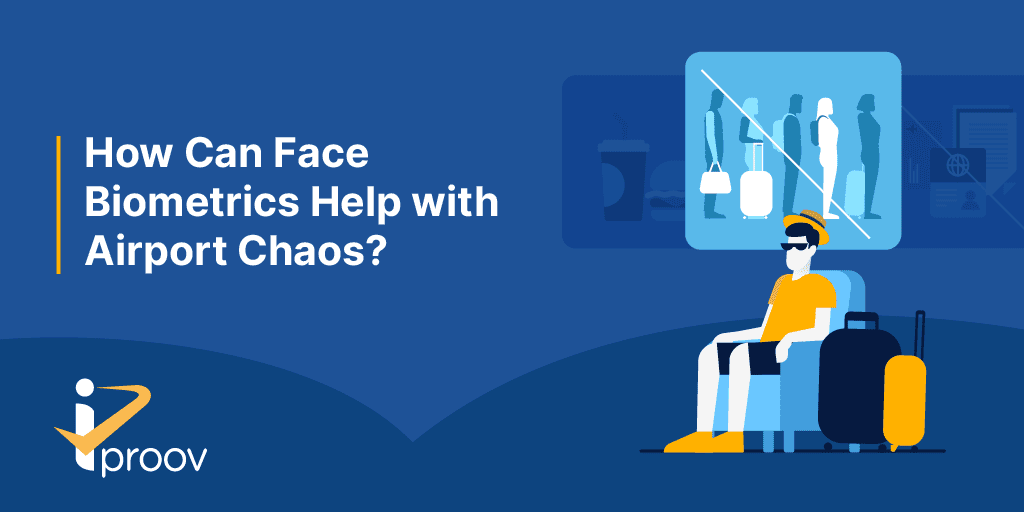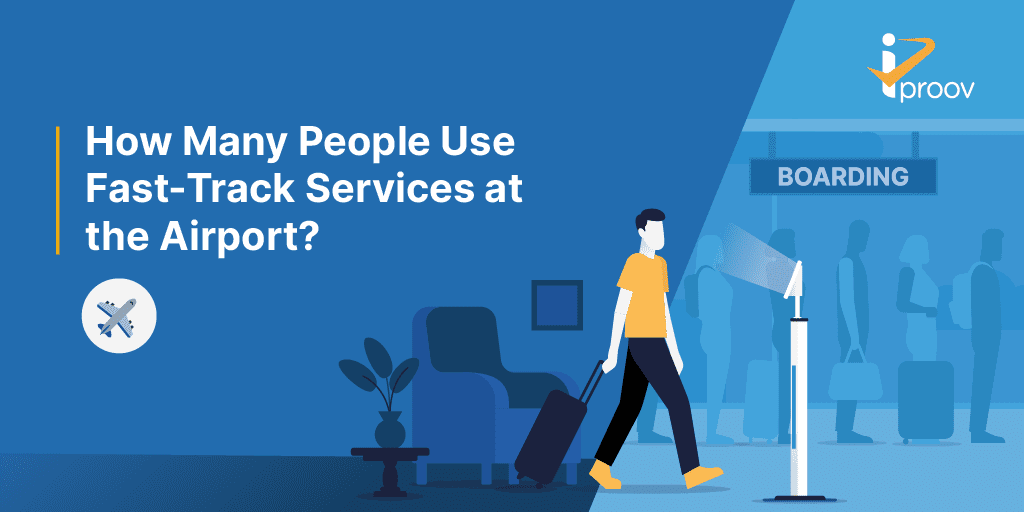July 12, 2022
Delayed vacations, canceled honeymoons and other travel turmoil. With the summer vacation season upon us, experts around the world are predicting further airport chaos – with some even recommending that travelers cancel holidays in order to avoid the frenzy and potential disappointment.
Travel is now surging after a period of depressed demand due to COVID-19, but staff levels have not returned to normal. This is leading to long lines, last-minute flight cancelations, and unhappy travelers.
Following our survey of over 16,000 travelers across the globe, iProov has some exclusive insights on the topic. If you’d like to jump straight to our travel whitepaper, download the full report here for all of the data and insights.
In this article, we’ll explain how travel could be improved with biometric authentication technology. By enabling remote document and ticket checks, airlines can reduce congestion and bottlenecks while improving the traveler experience.
The problem: why are airports experiencing chaos?
A number of factors have combined to create a “perfect storm” of airport chaos across the globe. In the UK, for example, airports attribute congestion to:
- Severe staff shortages: there is currently a record number of job vacancies across the British economy.
- A surge in demand following COVID-19: airports attribute much of the chaos to this being the first “post-covid” summer, where many passengers are using vouchers or credit notes from trips canceled during the pandemic, fuelling additional demand.
- Strike action: strikes are exacerbating airport chaos – most notably British Airways (BA) staff voting to go on strike over pay issues.
The situation has reached the point where the UK government called a meeting to discuss airport chaos, and a working group is being formed between the aviation industry and the UK government in order to address the issue.
Across the pond in the US, there’s a similar story. Demand for travel services is soaring post-COVID. Reuters predict a summer of “long lines, higher prices” as airlines, hotels, and rental car companies are all seeing an uptick in demand. Simultaneously, Reuters reports that the US travel industry is facing a tight labor market following 2+ years of depressed demand due to COVID-19.
The current airport process causes a number of issues for travelers. Long lines are the most common complaint (read the statistics here), but there’s more: travelers are often asked to get to the airports earlier to get through the manual checks, which combined with reduced staffing leads to even more lines. This leads to customer frustration and increased crowding which, combined with COVID, leads to people feeling more and more uncomfortable about the travel experience.
It’s therefore more important than ever that airports, airlines and other travel service providers find ways to streamline the travel experience as much as possible. Reducing the reliance on manual document checking is one such opportunity. Instead of asking travelers to show the same documents multiple times across the airport journey, the process can be automated using face biometric technology.
With face biometric technology, airports can provide a contactless method of identity verification that starts in the traveler’s home before they even set off – improving traveler experience, reducing queues and optimizing the secure verification process.
How can remote document and ticket checks using biometrics help to speed up the travel experience?
Biometric technology offers the convenience, security, efficiency, and inclusivity to make the travel experience faster and less congested.
So how does it work?
- A traveler is sitting at home on their couch the day before their flight (this could also be an international train journey, or other trip – but for the purpose of this article, we’re focusing on air travel). With their smartphone in hand, they begin the remote enrollment process
- iProov verifies the person against their government-issued photo ID, proving the genuine presence of the document owner and linking their face to their ticket
- The next day, the traveler arrives at the airport. They can now choose to use their face as their ticket and reduce the time they spend standing in long lines
Watch the animation to quickly understand how contactless “couch to gate” travel from iProov works:
What are the benefits of biometric-enabled document and ticket checks combined with automated touchpoints at airports?
- Enhanced customer experience through remote document and ticket checks: iProov enables customers to enroll from their couch and use their face as a ticket upon arrival at checkpoints without having to search through bags to find and show the right documentation. This also reduces congestion at key travel hub bottlenecks.
- Improved operational efficiency, reduced document handling, and less reliance on manual checks: secure contactless enrollment prior to arrival at airports offers a greater level of security without the need for manual checkpoint processes. Because your face is your ticket, there is no need for repeated checks by staff. Additionally, labor resources are also freed up by allocating the work to technology rather than staff. The security checks themselves become more effective, as by completing a face biometric verification within hours/days of traveling the airport security team have a very recent image to check against rather than using a potentially 10-year-old passport image – leading to faster transition through security checkpoints.
- Provide a differentiated service experience for travelers: by starting air traveler validation prior to arrival, new opportunities for highly personalized traveler experiences are created for both airlines and airports.
A recent Valour Consulting report found that:
- Self-service and automated touchpoints are forecast to account for 26% of revenues associated with the seamless passenger journey between 2020-2030
- There has been a 15% biometric adoption growth year-on-year in airports, anticipated to grow to 22.6% growth rate in 2025
- Pre-security e-gates were found to deliver performance improvements of between 30% and 250% over traditional manual processes
The data: would people be open to check-from-home services?
We’ve established how biometric check-from-home services can alleviate airport chaos by enhancing operational efficiency and easing bottlenecks. But would consumers use it?
The data says yes: 85% of 16,000 respondents in iProov’s recent survey said that they either would or might complete their ticket and ID checks from home to speed up the travel process.
The demand was highest in Spain and Italy, where over 90% of respondents showed a desire to use such a service. Even in Germany, where enthusiasm was lowest, almost four out of five people (78%) said they would or might use the option.

Clearly, consumers overwhelmingly like the idea of a pre-travel check service.
Face biometrics and airport chaos: a summary
- Airports across the globe are experiencing “airport chaos” as demand for travel is now surging after a period of depressed demand due to COVID-19. Other factors such as strikes and labor shortages are playing a key role too – creating turmoil for airports.
- Biometric authentication technology, like iProov’s Dynamic Liveness, can help to automate the process of verifying and authenticating ID documents remotely. This delivers convenience, security, efficiency, and inclusivity to speed up the travel experience.
If you’d like to learn more about how iProov can secure and streamline your travel organization’s remote document check, ticket check, and check-in services using face biometrics, book your demo today.


